Giant Magellan Telescope is an engineering marvel

The $2.54 billion Giant Magellan Telescope project is a partnership among 14 institutions around the world, including the University of Arizona. Enormous mirrors for the telescope come from Steward Observatory’s Richard F. Caris Mirror Lab.
Rebecca Bernstein, Ph.D., chief scientist for the Giant Magellan Telescope, describes the universe as the ultimate physics laboratory. “The universe can create things at extreme scales – extreme densities, extreme energies – that we can’t create on Earth,” she said.
Nevertheless, what scientists and engineers can create on Earth to study the cosmos is remarkable. Few of these creations are more impressive than the under-construction Giant Magellan Telescope. Conceived in the early 2000s, the telescope, part of a new generation of extremely large telescopes, will be the world’s most powerful when it goes online in the early 2030s.
A light-gathering powerhouse
At the heart of Giant Magellan is a petal-shaped arrangement of seven giant mirrors, each 8.4 meters in diameter, [fabricated in Steward Observatory's Richard F. Caris Mirror Lab]. For perspective, the James Webb Space Telescope measures 6.5 meters in total across its mirror segments. Collectively the mirrors of the Giant Magellan will function as one 25-meter-diameter imaging surface. The new telescope will be able to reach four times better spatial resolution than the Webb telescope. It will enable scientists to study exoplanets with 15 times greater resolution than with the Webb telescope.
Large mirrors have distinct advantages. “When you have smaller mirrors, you have miles and miles of edges in the middle of the mirror,” Bernstein said. “All those edges scatter a little bit of light, and that just adds background to your image.”
Its high-resolution imaging will enable scientists to study the complex interactions between the universe and the stars and planets within it – including our own. But the real achievements of Giant Magellan may prove to be the ones we can’t yet imagine.
“People like to say that telescopes are discovery machines,” Bruce Bigelow said. “So you build it partly because there’s things you’re looking for, but the most amazing things that the telescopes usually do are surprises. They discover things that were unanticipated.”
Read the full article, including a deep-dive into the precision of mirror fabrication, here.

